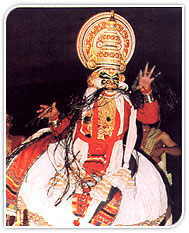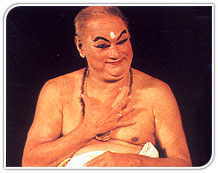Dances of India: Kathkali
 Kerala
presents to the country one of the most imposing and colourful spectacles
of dance - Kathakali. It is heroic, majestic and epic in character.
Kerala
presents to the country one of the most imposing and colourful spectacles
of dance - Kathakali. It is heroic, majestic and epic in character.
Though
this form of art is not more the 300 years old, the actual roots can be
traced to 1500 years earlier.
It symbolizes the blending of the
Aryan and Dravidian cultures and is presumed to be evolved out of the
various ancient theatre traditions of the region like Krishnattam,
Ramanattam Koodiyattam, Mudayyetu and Teyyam.
Mahakavi Vallathol
of Cherutoorthi (Palghat) contributed greatly in the evival of this art by
forming Kalamandalam, the famous teaching institution, set up in the
thirties.
The domain of Kathakali is peopled by superhuman,
gods, demons and animals. So the costume and make-up is also elaborate and
colourful.
 Green
is for heroic characters, black for evil and bearded countenance depicts
Hanuman and Bheema. Being a very exacting art it demands streneous and
long training for body and facial movements alongwith body massage and
diet control.
Green
is for heroic characters, black for evil and bearded countenance depicts
Hanuman and Bheema. Being a very exacting art it demands streneous and
long training for body and facial movements alongwith body massage and
diet control.
Mostly based on mythology and the themes of
Ramayana and Mahabharata, a Kathakali performance opens with the thunder
of drums which invites the audiences.
The performance lasts
night long and only men perform Kathakali. As a form of art. Kathakali is
a sophisticated, spectacle of the supernatural.
 Kerala
presents to the country one of the most imposing and colourful spectacles
of dance - Kathakali. It is heroic, majestic and epic in character.
Kerala
presents to the country one of the most imposing and colourful spectacles
of dance - Kathakali. It is heroic, majestic and epic in character.  Green
is for heroic characters, black for evil and bearded countenance depicts
Hanuman and Bheema. Being a very exacting art it demands streneous and
long training for body and facial movements alongwith body massage and
diet control.
Green
is for heroic characters, black for evil and bearded countenance depicts
Hanuman and Bheema. Being a very exacting art it demands streneous and
long training for body and facial movements alongwith body massage and
diet control.